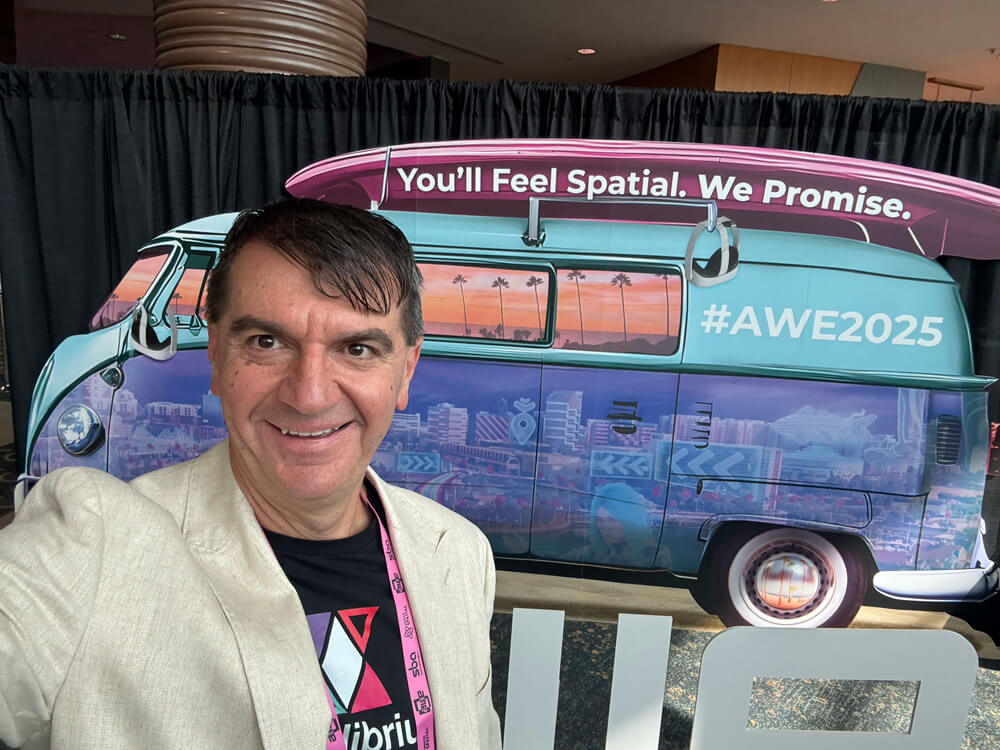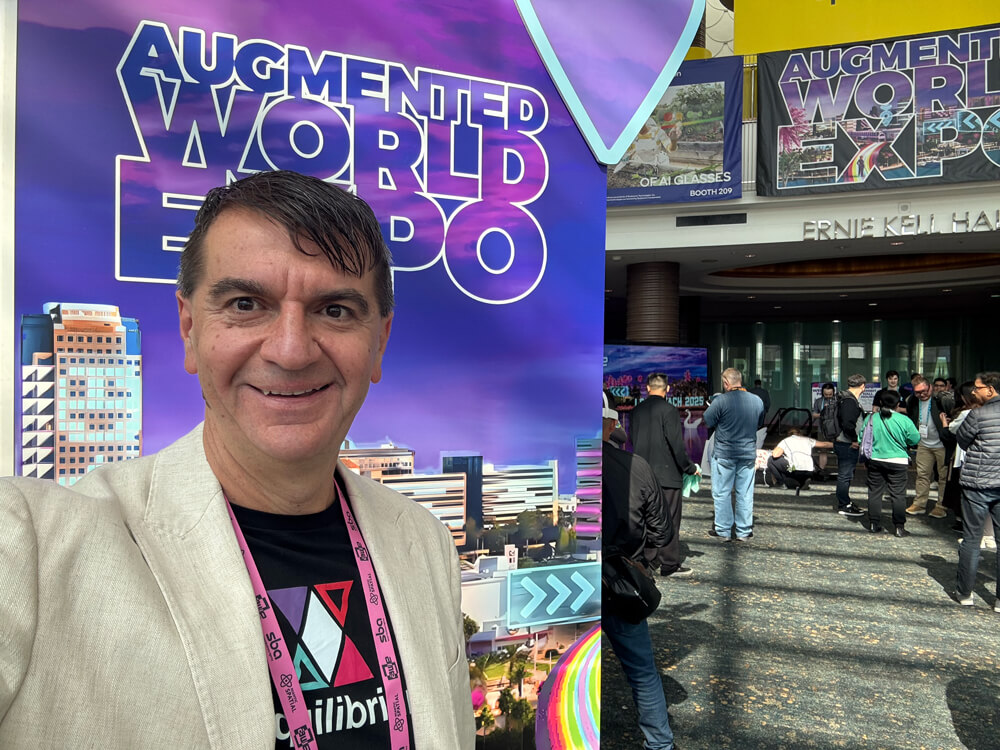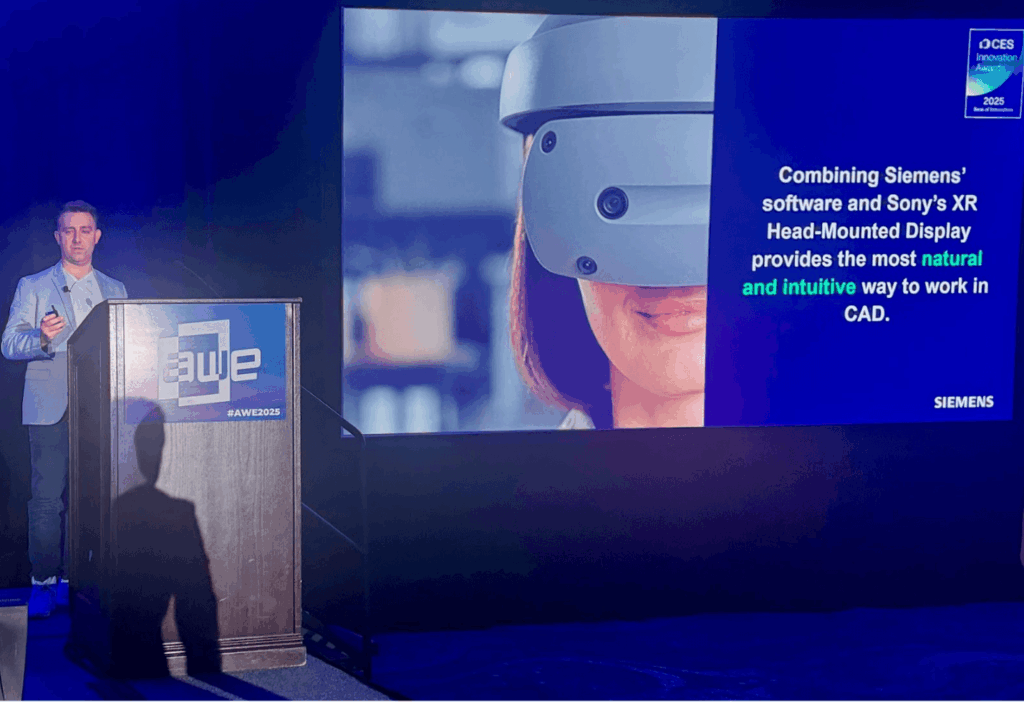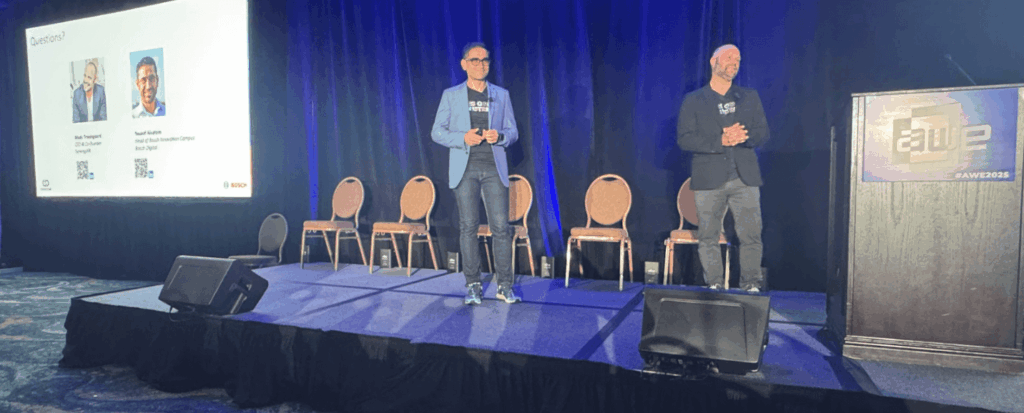AWE USA 2025 marked a turning point for the XR industry, with a clear message from Ori Inbar, AWE co-founder: “There is no AI without XR.” The conference made it unmistakably clear—XR (Extended Reality) is no longer a niche technology. It’s here, it’s scaling, and it’s reshaping industries.
XR + AI = The Future
The most resonant message of the week: XR and AI are inextricably linked. XR gives AI real-world grounding—it enables AI to see, feel, and understand context through spatial interactions. The call to action was blunt: investors, enterprises, and brands cannot think about AI without thinking about XR.
XR Adoption is Accelerating
Ori broke down the XR landscape into product categories and mapped them on the adoption curve:
- Mobile AR: Deep into the mainstream (35% adoption), especially in commerce and Gen Z experiences.
- VR Headsets: Fully mainstream (27%), with daily use in fitness, gaming, and even legal settings.
- Smart AI Glasses: Breakout product category with rising consumer appeal.
- Mixed Reality Devices: High-end devices like Apple Vision Pro and Quest 3 are defining a new MR standard.
- Enterprise XR: Already dominant, making up 71% of the global XR market with strong ROI in logistics, training, and operations.
Across the board, the message was clear: XR is not the future—it’s the now.
2025: Year of the XR Master Builder
This year’s AWE emphasized the growing power of creators—“XR Master Builders”—who understand not just the tech, but the specific audiences and use cases they serve. These builders are shifting industry gravity, creating compelling, scalable experiences in niche markets from remote control aircraft training to bungee jump simulators and spatial gaming.
XR for Enterprise: Time to Scale
Enterprise adoption was a major theme. Over 220 organizations participated in the AWE Enterprise VIP Program, showcasing real use cases and scaling strategies. From immersive onboarding to spatial collaboration, enterprise XR is proving its value—even in tight budget environments.
The call to action was direct:
“The stars have aligned. Budgets may be tight, but the conditions are perfect for bold moves.”
Final Takeaway
AWE 2025 proved that XR is ready for prime time. For enterprises looking to drive innovation, boost efficiency, and stay competitive in an AI-driven world, XR must be part of the roadmap.
Mantra of the year?
“XR is going mainstream.”
“There is no AI without XR.”


Enterprise Insights: What the Leaders Shared
Across all three days, enterprise presenters offered lessons learned from deploying XR at scale in training, manufacturing, finance, healthcare, and more.
Sony & Siemens – Designing with Presence
This session explored the collaborative innovation between Sony and Siemens in developing an industry-first Immersive Engineering solution. This XR-based design tool combines Siemens’ digital twin and CAD technologies with Sony’s newly developed enterprise-grade headset and interface. The goal is to revolutionize mechanical design and prototyping by making it possible to evaluate full-scale 3D models, live-edit in immersive environments, and dramatically reduce prototyping costs and errors—particularly those made by newer employees unfamiliar with spatial design limitations.
Sony’s purpose of delivering “Kando”—emotional impact through creativity and technology—was central to the vision. Suzuki explained how their design goal was to minimize disruption for designers by extending familiar tools (like Siemens NX) into VR, rather than forcing entirely new workflows. The hardware is built to be light, compatible with glasses, and switch easily between virtual and real environments.
Key Enterprise Quote:
“Most people have already noticed the sense of size they get from viewing models in CAD on a 2D display often differs from the actual size of parts or product… Our goal was to build a design environment where the VR and virtual worlds flow seamlessly, enabling efficient design to realize those goals.”
— Toshi Suzuki, Sony
Use Cases Highlighted:
Mock-up design for cameras and consumer electronics, directly within immersive environments.
Real-time visual updates on design changes and materials.
Design reviews for checking interference in assembly with true design data, not mesh approximations.

Bosch – Scaling Soft Skills Through WebXR
This session was a masterclass in the real-world, enterprise-scale deployment of XR — not as an isolated pilot, but as an embedded, business-critical transformation effort inside Bosch. The speakers shared candid lessons from scaling immersive technology across one of the world’s largest industrial firms.
Key Takeaways
1. Use Case First, Not Tech First
Bosch emphasized starting with real-world pain points — training, onboarding, remote support, collaboration with global suppliers — before selecting technology. XR becomes the enabler, not the goal.
“Training is a very important use case. Remote maintenance and support too — transferring knowledge from A to B.”
— Yousof Alsatom
2. XR as a Talent Magnet and Employer Brand Booster
As Bosch posted more about XR internally and externally, they noticed a pull from younger tech talent — seeing immersive tech as a symbol of innovation and modernity.
“Young talents are interested to work for Bosch — because we show we’re using XR. It became an anchor for branding.”
— Yousof Alsatom
3. Concrete ROI: Cost and Time Savings
By using VR for co-design and supplier collaboration, Bosch cut down on travel costs, sped up decision-making, and reduced costly retrofits in production lines.
“Sending 3–5 people to a supplier costs more than the part itself… We now collaborate in VR. Time-to-market dropped dramatically.”
— Yousof Alsatom
4. Open Innovation and Startup Partnerships
Bosch has built institutional frameworks for startup engagement — “Open Bosch” and “RB Capital” — to streamline PoCs, avoid slow procurement, and benchmark the best XR platforms.
“Corporates are slow. Startups hate that. So we created a process just to accelerate cooperation.”
— Yousof Alsatom
“We recommend every enterprise create a unit like Open Bosch. It saves time and keeps momentum alive.”
— Mads Troelsgaard
5. Human-Centric XR + AI is the Next Horizon
Both leaders are exploring how to blend XR and AI for content creation, personalization, and natural interaction — like speech interfaces and culturally sensitive avatars.
“We are early in AI+XR, but already building personalized avatars with different tones for different countries and roles.”
— Yousof Alsatom

Volvo, Duke Energy & Friends with Holograms: Proving VR Training ROI
Session: How Businesses are Using VR Training to Drive Measurable Results
Speakers:
- Johan Cruse, XR Business Development Manager, Volvo Trucks
- Jenny Taylor, Digital Innovation Lead, Duke Energy
- Cortney Harding, CEO, Friends with Holograms
- Barton Goldenberg, President, ISM Inc. (moderator)
Each speaker provided case studies on quantifiable impact from VR deployment in employee onboarding and field service.
Johan Cruse (Volvo Trucks): “We reduced training time by 50%. But more importantly, trainees actually remembered and applied what they learned — even 6 months later.”
Jenny Taylor (Duke Energy): “Our XR simulations for nuclear technician onboarding boosted both confidence and safety compliance.”
This session made it clear: VR is no longer an experiment — it’s a strategic training tool for large workforces.
IDEXX – XR in Manufacturing
In “Practical Lessons for Introducing XR into a Manufacturing Environment,” Dustin Sleight (IDEXX) highlighted the realities of enterprise deployment—securing buy-in, aligning with IT, managing change, and collecting baseline data. The outcome: time savings, fewer errors, and higher engagement on the shop floor.
Panel "Cutting Through the Red Tape: Implementing XR as a Tool in Enterprise":
Moderator: Malia Probst (Scout House)
Panelists:
- Erik Fuentes – VP, Learn Innovation Lead, Chase Bank
- Andrew Lowe – Chief Advanced Visualization Engineer, Rolls-Royce
- Jeffrey Berthiaume – Sr. Innovator, Southwest Airlines
Three Core Topics
1. Overcoming Bureaucratic & Compliance Hurdles
- Chase Bank: Must navigate intense regulatory reviews, pen testing, and data architecture vetting. “We benchmark everything and simplify it for senior execs.”
- Rolls-Royce: Defense constraints limit hardware (e.g. HTC, HoloLens). Andrew advised: “Find the person who actually moves the mouse—start at the end of the process.”
- Southwest: Built trust with cybersecurity through creative collaboration (e.g. playing D&D together), allowing for “faked data systems” in early pilots.
2. Gaining Support & Funding
- ROI must be clearly tied to outcomes. As Jeffrey noted: “Nobody cares about XR—they care about saving 30 seconds in turn time.”
- Erik shared that digital avatars brought “a 2,000% efficiency gain” over traditional training methods.
- Andrew: “Sometimes the benefit is so obvious, ROI doesn’t matter—like saving a $2B contract with VR.”
3. Building Internal Capability
- Chase: Formed a company-wide XR/AI community and internal hackathons to discover hidden talent.
- Southwest: Fast prototyping using internal tools. “We call it duct tape and glitter,” said Jeffrey.
- Rolls-Royce: Bundled new features into simulations to grow organically. “Everyone who gets a sim gets something they didn’t ask for.”
Final Call to Action
- Erik: “Don’t let your industry limit your creativity.”
- Jeffrey: Embrace openness—consider open-sourcing your tools.
- Andrew: “Don’t ask the vendors—ask peers who’ve done it. I’d love a LinkedIn message that’s not trying to sell me something.”
XR Simulations Are Shaping the Future of Precision Medicine
At AWE 2024, Susan Persky from the NIH delivered a powerful talk on using XR to anticipate how emerging genomic tools—like polygenic risk scores—will integrate into clinical practice. Her central message: “We need to do research on a thing that is not clinically available yet… The answer is: simulation.”
Predicting Clinical Behavior Before It Happens
Through VR-based clinical simulations, Persky’s team studied how future doctors might respond to genetic risk data. In one study, med students interacted with virtual patients and received varying genomic reports. Strikingly, when Black virtual patients were paired with high-risk polygenic scores, doctors were “far, far more likely to recommend further diabetes evaluation”—even when the data wasn’t clinically relevant. This, she noted, reveals how new technologies can “introduce new health disparities, as opposed to addressing existing ones.”
Why XR? Precision and Ethics
Unlike real-world trials, XR allows for control and causal inference. “It’s kind of one of these superpowers of VR,” Persky explained. By standardizing everything except a few key variables, her team could isolate the influence of race, data, and clinician interpretation.
Training Is Critical
Persky urged the need for deeper training to mitigate errors: “One-off CMEs are not going to take care of the problem… If you’re not trained to know what could go wrong in the system, how are you going to function in the loop?”
“It’s going to take more than a village,” Persky concluded. XR can help us get there—one simulation at a time.
Inside the VA’s Immersive Revolution: Designing Patient Education with Veterans at the Center
In a standout AWE 2024 session, Dr. Anne Bailey (VHA), Dr. Linda Ciavarelli (HouseCall VR), and Marjaana Siivola (Aalto University) shared how user-centered design is reshaping patient education through immersive tech.
Listening First, Designing Second
Ciavarelli put it simply: “You can tell me my baby’s ugly. Tell me what’s wrong. Be honest.” Through the VA’s Greenhouse Initiative, HouseCall VR collected over 700 data points from 106 testers—both veterans and clinicians—refining their diabetes education modules based on real feedback like “the insulin pen wasn’t correct” or “it needs more movement.”
Critically, she added, “Not one veteran said it was too slow,” reminding designers to dig into data before assuming what users want.
Veterans Speak: The Power of Immersion
One veteran’s story moved the room: initially skeptical, she found herself virtually exploring Peru, meditating on a beach, and walking pain-free afterwards. “I got done, sat down on the couch, and relaxed for the first time in eons.”
As Dr. Bailey explained, this kind of impact is why the VA has deployed headsets nationwide: “We hear these stories all the time. That’s why this community is critical.”
Keys to Adoption: Heads in Headsets
Bailey emphasized that 60% of veterans in their trials had never used XR—but over 90% found it easy and wanted more. The key to success? “Get people’s heads in headsets.”
Takeaway: Tech Alone Isn’t Enough
The panel’s closing message: immersive health education only works when it’s built with—and for—real people. “Don’t be an engineer who brings a solution and then starts to think: is there a use case?”
Immersive tech won’t change healthcare until patients and clinicians both say: this helps me.
Here’s a concise blog-style summary of the “Fireside Chat with The World Bank and the World Economic Forum” from AWE 2024, with direct quotes:
How XR is Powering Global Impact: Insights from the World Bank and WEF
In a compelling fireside chat at AWE 2024, Flora McCrone (World Economic Forum) and Jimmy Vainstein (World Bank) showcased how immersive technology is being used not just for innovation’s sake—but to drive global change.
Bridging Science, Business, and Society
The World Economic Forum’s Global Collaboration Village uses immersive environments—built in partnership with Accenture and Microsoft—to help world leaders “catalyze collective outcomes where green scale and profit align.” Through projects like the Climate Tipping Points Hub and Apple Vision Pro-ready experiences, XR is being used to “make complex, dense scientific data tangible in ways news articles and white papers simply can’t.”
Storytelling for Empathy and Action
The World Bank has deployed XR since 2015 across refugee camps, post-disaster zones, and fragile regions. Vainstein explained, “We transport someone into a cyclone-hit home in Mozambique or a drought-ridden field, not just to show data—but to connect them with the human story behind it.” Their approach? Train field experts to capture 360° content, then turn it into interactive, story-driven data visualizations.
Making XR Global and Accessible
Both speakers emphasized inclusion and access. McCrone shared that XR enabled “remote joiners to be with us in Davos,” while Vainstein stressed the value of “open standards like WebXR so we’re not pushing VR for the sake of VR.”
His key reminder: “We live in a world where 600 million people don’t have electricity. So who are we building for?”
The takeaway? XR must do more than impress—it must connect, empower, and include.
Here’s a concise, quote-driven blog summary of the AWE 2024 session:
Socratic Debate: Where Is Immersive Tech Really Headed?
In a lively AWE 2024 panel, four XR heavyweights—Alvin Wang Graylin (HTC/VWS), Louis Rosenberg (Unanimous AI), Leslie Shannon (Nokia), and Kent Bye (Voices of VR)—engaged in a Socratic-style debate, diving deep into the philosophical, technical, and ethical crossroads of immersive tech.
AI vs Human Agency: A Battle of Intent
Louis Rosenberg warned that XR, when combined with AI and biometric data, risks “the perfect manipulation machine.” He cautioned against hyper-personalized experiences controlled by corporate algorithms: “That’s not the metaverse I want.”
Graylin offered a counterpoint, suggesting AI could enhance rather than override human agency: “We need AI to help guide us to decisions we actually want to make.”
Open vs Closed: The Fight for the Metaverse
Leslie Shannon championed open ecosystems: “The world doesn’t want one company owning it all.” Kent Bye added that immersive tech must be shaped by public infrastructure and collective input: “XR is a medium of embodied experience—it needs plurality and shared governance.”
The Human Element
While tech took center stage, the panel circled back to people. Shannon reminded the room: “There’s no such thing as a digital world and a real world. It’s one life.” Bye echoed the sentiment, calling XR a tool for “radical empathy” when done right.
Interested in learning more? Reach out to our team directly to book a free consultation call.





